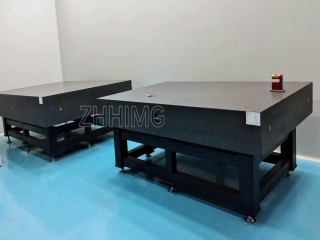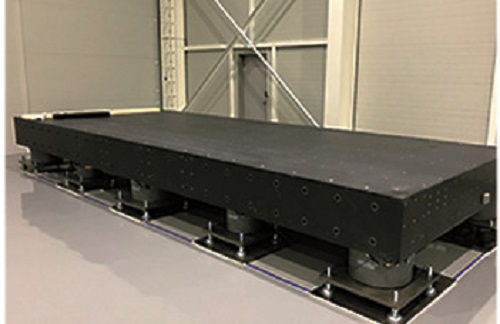In the field of semiconductor testing, the material selection of the testing platform plays a decisive role in the testing accuracy and equipment stability. Compared with traditional cast iron materials, granite is becoming the ideal choice for semiconductor testing platforms due to its outstanding performance.
Outstanding corrosion resistance ensures long-term stable operation
During the semiconductor testing process, various chemical reagents are often involved, such as potassium hydroxide (KOH) solution used for photoresist development, and highly corrosive substances like hydrofluoric acid (HF) and nitric acid (HNO₃) in the etching process. Cast iron is mainly composed of iron elements. In such a chemical environment, oxidation-reduction reactions are highly likely to occur. Iron atoms lose electrons and undergo displacement reactions with acidic substances in the solution, causing rapid corrosion of the surface, forming rust and depressions, and damaging the flatness and dimensional accuracy of the platform.
In contrast, the mineral composition of granite endows it with extraordinary corrosion resistance. Its main component, quartz (SiO₂), has extremely stable chemical properties and hardly reacts with common acids and bases. Minerals such as feldspar are also inert in general chemical environments. A large number of experiments have shown that in the same simulated semiconductor detection chemical environment, the chemical corrosion resistance of granite is more than 15 times higher than that of cast iron. This means that using granite platforms can significantly reduce the frequency and cost of equipment maintenance caused by corrosion, extend the service life of the equipment, and ensure the long-term stability of detection accuracy.
Ultra-high stability, meeting the requirements of nanometer-level detection accuracy
Semiconductor testing has extremely high requirements for the stability of the platform and needs to precisely measure the characteristics of the chip at the nanoscale. The coefficient of thermal expansion of cast iron is relatively high, approximately 10-12 ×10⁻⁶/℃. The heat generated by the operation of the detection equipment or the fluctuation of the ambient temperature will cause significant thermal expansion and contraction of the cast iron platform, resulting in a positional deviation between the detection probe and the chip and affecting the measurement accuracy.
The coefficient of thermal expansion of granite is only 0.6-5×10⁻⁶/℃, which is a fraction or even lower of that of cast iron. Its structure is dense. The internal stress has been basically eliminated through long-term natural aging and is minimally affected by temperature changes. In addition, granite has strong rigidity, with a hardness 2 to 3 times higher than that of cast iron (equivalent to HRC > 51), which can effectively resist external impacts and vibrations and maintain the flatness and straightness of the platform. For instance, in high-precision chip circuit detection, the granite platform can control the flatness error within ±0.5μm/m, ensuring that the detection equipment can still achieve nanoscale precision detection in complex environments.
Outstanding anti-magnetic property, creating a pure detection environment
The electronic components and sensors in semiconductor testing equipment are extremely sensitive to electromagnetic interference. Cast iron has a certain degree of magnetism. In an electromagnetic environment, it will generate an induced magnetic field, which will interfere with the electromagnetic signals of the detection equipment, resulting in signal distortion and abnormal detection data.
Granite, on the other hand, is an antimagnetic material and is hardly polarized by external magnetic fields. The internal electrons exist in pairs within the chemical bonds, and the structure is stable, not affected by external electromagnetic forces. In a strong magnetic field environment of 10mT, the induced magnetic field intensity on the surface of granite is less than 0.001mT, while that on the surface of cast iron is as high as more than 8mT. This feature enables the granite platform to create a pure electromagnetic environment for the detection equipment, especially suitable for scenarios with strict requirements for electromagnetic noise such as quantum chip detection and high-precision analog circuit detection, effectively enhancing the reliability and consistency of the detection results.
In the construction of semiconductor testing platforms, granite has comprehensively surpassed cast iron materials due to its significant advantages such as corrosion resistance, stability and anti-magnetism. As semiconductor technology advances towards higher precision, granite will play an increasingly crucial role in ensuring the performance of testing equipment and promoting the progress of the semiconductor industry.
Post time: May-15-2025


